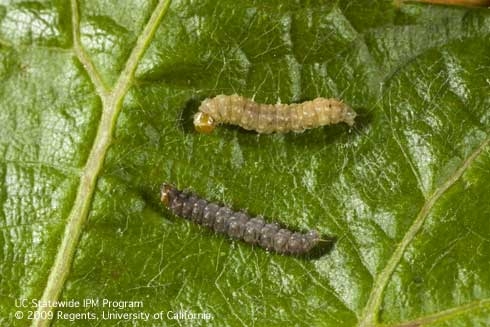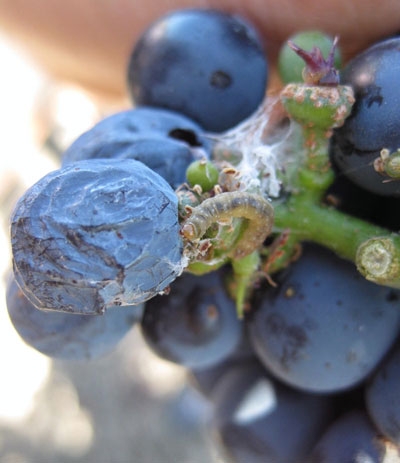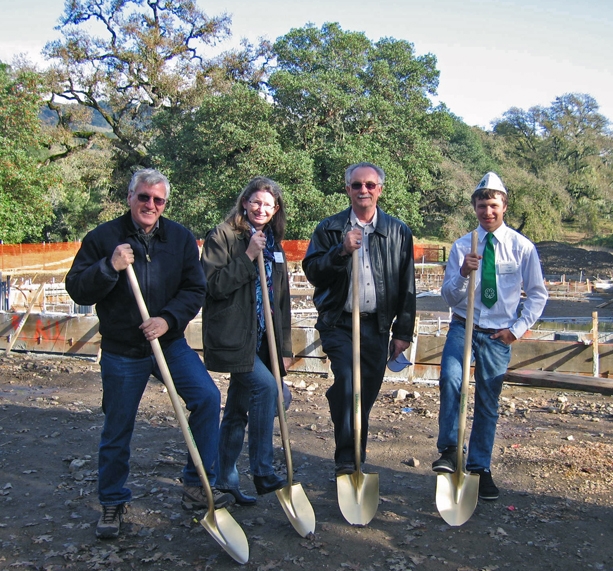Posts Tagged: napa
Hopland REC builds conference room
The article quotes Bob Timm, the center's director, as saying, "We want to talk to people about whether our vision meets what the needs in the community are -- we want a building that fits into Mendocino County." Timm hopes the building will help the center expand its community outreach programs by being a site for workshops, conferences and classes.
The $1.6 million project is funded by UC capital construction funds and private donations to the project.
Timm is encouraging gifts from the community so that that the facility including the added “Green Works” elements can be completed within the coming months. Descriptions of the building plans and added features are found on the Hopland REC website at http://ucanr.org/sites/hopland.
U.S. EPA, Napa County announce millions for water quality, flood damage, northern California salmon
An EPA press release announced nearly $3.3 million in federal, state and local funding aimed at restoring water quality and riparian and aquatic habitats in the Napa River watershed. As part of two major restoration efforts covering 15 miles of the Napa River, more than 40 landowners have committed to converting nearly 135 acres of farmland to wildlife habitat.
The primary grant recipient is Napa County, in partnership with the Napa County Resource Conservation District, the California Land Stewardship Institute, UC Cooperative Extension and the Rutherford Dust Restoration Team of the Rutherford Dust Society landowner group.
Local food blazing a trail on Napa County map
Responding to Napa County's higher-than-average interest in healthy foods, sustainable principles and wellness lifestyle, the board of supervisors last year created a Local Food Advisory Council. Now the council is looking for citizen input to pursue new initiatives, according to a blog on the Napa County Register website.
Monica Cooper, director of the Napa County University of California Cooperative Extension, is an ex-officio member of the council. Cooper is the county’s viticulture farm advisor and a big champion of expanding local food production, according to a previous article in the newspaper.
“It’s important to have more crop diversity,” Cooper was quoted in the story, and she sees that in small plots, not wide swaths of the county.
Napa's Local Food Advisory Council has identified three priority areas and is seeking volunteers to serve on subcommittees for:
- Education and Outreach: Help design communications networks to encourage public involvement and information sharing, such as advocacy programs, printed materials, events, website, social media, etc.
- Local Food Production and Distribution: Help develop mutually beneficial food supply systems linking local farmers to community kitchens, markets and residents;
- Food Policy: Help influence and communicate county rules, regulations and fees for growing, selling and/or donating food products by both home and commercial producers.

Napa's soil, climate, natural resources and culture position the community to make a positive impact promoting locally grown food and healthful consumption.
European grapevine moth found in Mendocino
As authorities collaborate on a battle plan to combat European grapevine moth, the pest has been detected in a new area.
The Santa Rosa Press Democrat reported last week that 13 moths were found in a North Ukiah chardonnay vineyard, the first evidence the pest has reached Mendocino County. The discovery of the moths means that a quarantine with a three-mile radius around the vineyard will be established.
Mendocino County Ag Commissioner Tony Linegar believes the moth was transported on winegrapes from Napa County, where infestations are high, the story said. European grapevine moth, a native of the Mediterranean region, was first detected in California's wine country last September.
Meanwhile, the Napa Valley Register reported today that USDA is forming a technical team with experts from Italy, Chile and the University of California to determine the next steps in an effort to eradicate the new pest.Napa County Ag Commissioner Dave Whitmer, speaking to the Napa County Board of Supervisors last week, outlined a control strategy that includes additional trapping, working with growers where the pest has been found, maintaining quarantine standards and doing educational outreach, according to the article, written by Mike Treleven.
Grape industry leader Jon Ruel applauded the the efforts of the ag commissioner and UC Cooperative Extension for jumping on the issue early, Treleven reported.
“Dave (Whitmer) has done a good job to get state and federal agencies involved ... for getting money and a Technical Task Force, which drew the best scientists in the world,” Ruel was quoted.

Earlier stages of EGM larvae are tan to yellow-brown (top). Later stages are brown.
Is *suitcase smuggling* to blame for new pest?
A few of California's top vintners admit to having smuggled grapevine cane cuttings into the United States to avoid a long wait for the plant to be cleared by USDA, according to an article that moved on the Associated Press wire over the weekend. The article was published in the Fresno Bee, the New York Times and other media outlets.
Some are wondering if what reporter Tracie Cone wrote is a "winked-at act of sneaking in vines" from Europe may have also imported the European grapevine moth, an Italian pest now threatening Napa vineyards.
The deputy agricultural commissioner for Napa County, Greg Clark, expressed his frustration with the practice of suitcase smuggling.
"There are people who continue to spin their tales of smuggled plant material," Clark was quoted. "People like a story with a glass of wine, and what that tends to do is legitimize behavior that not only threatens the industry, it's illegal. Knock it off."
Director of the UC Davis Foundation Plant Services, Deborah Golino, said some of the plant virus problems in Napa may also result from smuggling.
"The more we move plants around the world, the more chance there is of introducing problems," Golino was quoted.
Other theories about how the pest came to California are swirling around, the story said. In addition to the smuggled grapevine rumors, talk has centered around imported vineyard machinery or even deliberate introduction. Since the first detection of the pest was no where near a seaport, ag officials believe it unlikely the pest was transported on a container ship.
But UC Cooperative Extension viticulture farm advisor Monica Cooper said the moth's life cycle wouldn't be conducive to suitcase smuggling.
"I'm not saying that people don't still try to get suitcase wood in, but in this instance, I'm not sure the pest would be transported like that," Cooper was quoted.
More information and photos of the European grapevine moth are available on the UC Integrated Pest Management Web site.

European grapevine moth larva feeding on berries. (Photo: M. Cooper )

